Adaptive plasticity in tachykinin and tachykinin receptor expression after focal cerebral ischemia is differentially linked to gabaergic and glutamatergic cerebrocortical circuits and cerebrovenular endothelium
- PMID: 11157066
- PMCID: PMC6762313
- DOI: 10.1523/JNEUROSCI.21-03-00798.2001
Adaptive plasticity in tachykinin and tachykinin receptor expression after focal cerebral ischemia is differentially linked to gabaergic and glutamatergic cerebrocortical circuits and cerebrovenular endothelium
Abstract
To test the hypothesis of an involvement of tachykinins in destabilization and hyperexcitation of neuronal circuits, gliosis, and neuroinflammation during cerebral ischemia, we investigated cell-specific expressional changes of the genes encoding substance P (SP), neurokinin B (NKB), and the tachykinin/neurokinin receptors (NK1, NK2, and NK3) after middle cerebral artery occlusion (MCAO) in the rat. Our analysis by quantitative in situ hybridization, immunohistochemistry, and confocal microscopy was concentrated on cerebrocortical areas that survive primary infarction but undergo secondary damage. Here, SP-encoding preprotachykinin-A and NK1 mRNA levels and SP-like immunoreactivity were transiently increased in GABAergic interneurons at 2 d after MCAO. Coincidently, MCAO caused a marked expression of SP and NK1 in a subpopulation of glutamatergic pyramidal cells, and in some neurons SP and NK1 mRNAs were coinduced. Elevated levels of the NKB-encoding preprotachykinin-B mRNA and of NKB-like immunoreactivity at 2 and 7 d after MCAO were confined to GABAergic interneurons. In parallel, the expression of NK3 was markedly downregulated in pyramidal neurons. MCAO caused transient NK1 expression in activated cerebrovenular endothelium within and adjacent to the infarct. NK1 expression was absent from activated astroglia or microglia. The differential ischemia-induced plasticity of the tachykinin system in distinct inhibitory and excitatory cerebrocortical circuits suggests that it may be involved in the balance of endogenous neuroprotection and neurotoxicity by enhancing GABAergic inhibitory circuits or by facilitating glutamate-mediated hyperexcitability. The transient induction of NK1 in cerebrovenular endothelium may contribute to ischemia-induced edema and leukocyte diapedesis. Brain tachykinin receptors are proposed as potential drug targets in stroke.
Figures

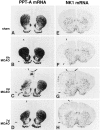
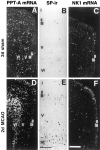
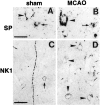
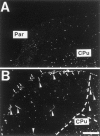
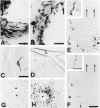

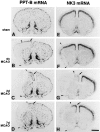
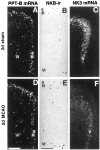


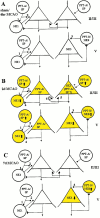
Similar articles
-
A role for tachykinins in female mouse and rat reproductive function.Biol Reprod. 2003 Sep;69(3):940-6. doi: 10.1095/biolreprod.103.017111. Epub 2003 May 28. Biol Reprod. 2003. PMID: 12773411
-
Characterization of tachykinin receptors in the uterus of the oestrogen-primed rat.Br J Pharmacol. 1998 Jan;123(2):259-68. doi: 10.1038/sj.bjp.0701613. Br J Pharmacol. 1998. PMID: 9489614 Free PMC article.
-
Gastric ulcer induced changes in substance P and Nk1, Nk2, Nk3 receptors expression in different stomach localizations with regard to intrinsic neuronal system.Histochem Cell Biol. 2019 Jan;151(1):29-42. doi: 10.1007/s00418-018-1715-4. Epub 2018 Aug 28. Histochem Cell Biol. 2019. PMID: 30155561 Free PMC article.
-
Tachykinins in the gut. Part I. Expression, release and motor function.Pharmacol Ther. 1997;73(3):173-217. doi: 10.1016/s0163-7258(96)00195-7. Pharmacol Ther. 1997. PMID: 9175155 Review.
-
Molecular recognition of tachykinin receptor selective agonists: insights from structural studies.Mini Rev Med Chem. 2013 Dec;13(14):2036-46. doi: 10.2174/13895575113139990079. Mini Rev Med Chem. 2013. PMID: 23937231 Review.
Cited by
-
CXCR4 regulates interneuron migration in the developing neocortex.J Neurosci. 2003 Jun 15;23(12):5123-30. doi: 10.1523/JNEUROSCI.23-12-05123.2003. J Neurosci. 2003. PMID: 12832536 Free PMC article.
-
Neuroprotection by endogenous and exogenous PACAP following stroke.Regul Pept. 2006 Nov 15;137(1-2):4-19. doi: 10.1016/j.regpep.2006.06.016. Epub 2006 Oct 4. Regul Pept. 2006. PMID: 17027094 Free PMC article.
-
Chronic systemic infection exacerbates ischemic brain damage via a CCL5 (regulated on activation, normal T-cell expressed and secreted)-mediated proinflammatory response in mice.J Neurosci. 2010 Jul 28;30(30):10086-95. doi: 10.1523/JNEUROSCI.1227-10.2010. J Neurosci. 2010. PMID: 20668193 Free PMC article.
-
Somatostatin receptor 2 is activated in cortical neurons and contributes to neurodegeneration after focal ischemia.J Neurosci. 2004 Dec 15;24(50):11404-15. doi: 10.1523/JNEUROSCI.3834-04.2004. J Neurosci. 2004. PMID: 15601946 Free PMC article.
-
Role of Monoamine Oxidase Activity in Alzheimer's Disease: An Insight into the Therapeutic Potential of Inhibitors.Molecules. 2021 Jun 18;26(12):3724. doi: 10.3390/molecules26123724. Molecules. 2021. PMID: 34207264 Free PMC article. Review.
References
-
- Angerer LM, Cox KH, Angerer RC. Demonstration of tissue-specific gene expression by in situ hybridization. Methods Enzymol. 1987;152:649–661. - PubMed
-
- Baluk P, Bowden JJ, Lefevre PM, McDonald DM. Upregulation of substance P receptors in angiogenesis associated with chronic airway inflammation in rats. Am J Physiol. 1997;273:L565–L571. - PubMed
-
- Belayev L, Busto R, Zhao W, Ginsberg MD. Quantitative evaluation of blood-brain barrier permeability following middle cerebral artery occlusion in rats. Brain Res. 1996;739:88–96. - PubMed
-
- Blanchet F, Gauchy C, Perez S, Soubrie P, Glowinski J, Kemel ML. Distinct modifications by neurokinin1 (SR140333) and neurokinin2 (SR48968) tachykinin receptor antagonists of the N-methyl-d-aspartate-evoked release of acetylcholine in striosomes and matrix of the rat striatum. Neuroscience. 1998;85:1025–1036. - PubMed
-
- Bonner TI, Affolter HU, Young AC, Young WD. A cDNA encoding the precursor of the rat neuropeptide, neurokinin B. Brain Res. 1987;388:243–249. - PubMed
Publication types
MeSH terms
Substances
LinkOut - more resources
Full Text Sources
Other Literature Sources
